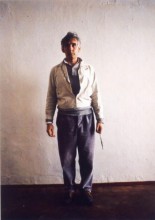Guy Mees (1935 -2003)
Guy Mees first gained recognition as a member of the Nieuwe Vlaamse School (New Flemish School) that formed in Antwerp in 1960 who, thanks to their contact with many of the artists affiliated with the international ZERO network, mounted a number of group shows throughout Europe during their brief existence. It was during this period that Mees developed his breakthrough series "Verloren Ruimte" ("Lost Space"), 1960–1967, which comprised wall-mounted monochromatic panels and freestanding neon objects, both of which were covered in lace. This early body of work–titled in reference to the artist’s desire to shatter pictorial space–constitutes a programmatic assertion of Mees's working method, which was relentlessly experimental and deliberately open-ended and malleable.
Though distinct in their appearance, subsequent series maintain the same emphasis on the deconstruction of preconceived notions around medium and style in order to investigate the concept of space itself. In a recently discovered series of sculptures begun in 1970, Mees subtly undermines the seriality and rationality commonly associated with Minimalist practices. Placed on the floor, these strips of metal were arranged in a geometric configuration. Visitors were then allowed to move individual pieces around the gallery, emphasizing the precariousness of such structures. Despite their industrial materials, these works are inherently fragile–an overarching characteristic of Mees's oeuvre.
Likewise, his series "Niveauverschillen" ("Differences in Levels") from the 1970s consisted of snapshot-like photographs of individuals arranged on different levels of a makeshift platform meant to mimic those used to award Olympic medals. Presented in a variety of formats, these images present a humorous take on the conceptual photography that was beginning to emerge during this period.
The later part of Mees's oeuvre is characterised by his inventive use of color as a means of delineating space. In the mid-1980s, he returned to the notion of lost space, creating a second series of Verloren Ruimte works, which he pursued through the early 1990s. Bearing little physical relation to the earlier, eponymous series, this second group took the form of thin scraps of colored paper cut in varying shapes and pinned to the wall.

